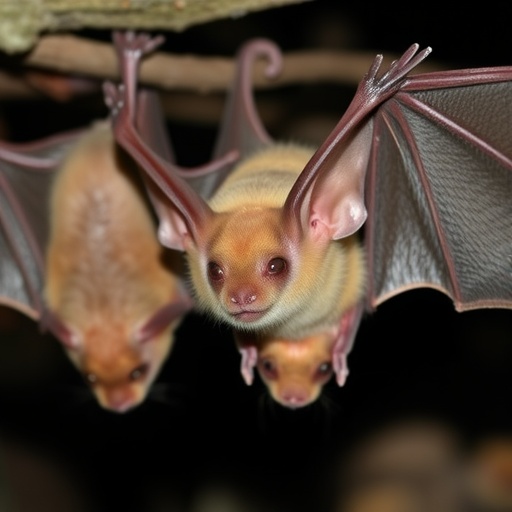Scientists at Tel Aviv University have uncovered intricate behavioral strategies fruit bats employ when competing with invasive black rats for limited food resources, revealing a seasonal dynamism in their interactions. This groundbreaking study, conducted over several months in a controlled yet semi-natural setting, sheds light on the nuanced balance animals maintain between foraging efficiency and survival instincts when facing interspecies competition and predation threats.
Fruit bats, specifically the Egyptian fruit bat species, share ecological niches with black rats, which not only compete for identical food supplies—primarily fruits—but also pose a predatory threat, especially toward vulnerable juveniles. Recognizing the dual risk of resource competition and direct predation, researchers set out to observe how bats adjust their foraging tactics in response to rat presence across different seasons, thereby offering unique insights into behavioral ecology and adaptive survival mechanisms.
The team from Tel Aviv University’s School of Zoology, led by Prof. Yossi Yovel alongside doctoral candidates Xing Chen and Adi Rachum, utilized extensive video monitoring to analyze more than 150,000 individual bat landings near designated food sources. This extensive dataset enabled a quantitative evaluation of how black rat encounters influence bat behavior, illustrating marked declines in bat landing frequencies concurrent with rat activities, indicative of a clear avoidance strategy.
Analysis revealed that the presence of rats induces heightened vigilance in fruit bats, manifesting as prolonged environmental scanning and hesitation before approaching food. Such changes culminate in a notable 20% decrease in foraging success under threat conditions, emphasizing the cost of antipredator behavior in resource acquisition. This implies that fruit bats allocate cognitive and energetic resources not only towards obtaining nutrition but also toward assessing predation risk, a complex behavioral balance rarely quantified so precisely in wild mammals.
Intriguingly, the seasonal context substantially modulates these behavioral patterns. During winter months, when black rat populations and consequent interactions are comparatively sparse, bats exhibit conservative strategies characterized by avoidance and continual visual surveillance. Conversely, as spring transitions into summer, increased food abundance paradoxically intensifies competitive pressures, leading bats to occasionally confront rats directly, a significant deviation from their generally cautious demeanor.
These confrontations, while inherently risky and potentially leading to injuries, appear to afford fruit bats improved foraging outcomes. Recorded data demonstrated a rise in foraging efficiency to approximately 60% during summer months, compared to a mere 35% success rate in winter. This seasonal behavioral plasticity suggests that bats weigh the benefits of aggressive competition against potential costs in a context-dependent manner, optimizing survival and energy intake according to environmental cues.
The study’s authors emphasize that traditional depictions of interspecies relations often fall into binary categories such as pure competition or predator-prey dynamics. However, this research highlights a more fluid and multifaceted interaction where overlap in these ecological roles prompts complex adaptive responses. Fruit bats not only evade predation risks but also strategically engage in contests for resources, demonstrating sophisticated behavioral modulation over temporal scales.
These findings underline the importance of longitudinal, high-resolution observational studies for capturing the subtle adaptive strategies employed by urban wildlife, often overlooked in field research constrained to shorter durations or simplistic behavioral categorizations. The experimental design combining naturalistic social colony settings with intensive video surveillance represents an innovative approach to study animal behavior with ecological validity.
Moreover, this research holds broader implications for understanding how urban ecosystems shape the evolutionary trajectories of species interacting within human-impacted environments. As urbanization accelerates, species like fruit bats and black rats increasingly share overlapping habitats, accentuating the relevance of such competitive and predatory interactions in shaping wildlife community dynamics.
The team’s work, documented and peer-reviewed in the journal BMC Biology, not only advances our knowledge of chiropteran behavioral ecology but also contributes methodological innovations for future studies in evolutionary biology and urban ecology. Video footage accompanying the study vividly captures these rare bat-rat interactions, including episodes of physical aggression where bats assert dominance, illustrating evolutionary strategies balancing risk and reward in resource competition scenarios.
Prof. Yovel further notes that investigating these behavioral responses unveils the remarkable plasticity of wild animals, reflecting their capacity to navigate and survive in highly variable and anthropogenically-altered environments. The research stands as a testament to the complexity of ecological interactions and highlights the adaptive ingenuity of bats as they negotiate the challenges imposed by invasive species and fluctuating resource landscapes.
Ultimately, this inquiry transcends simple ecological models by revealing how animals integrate sensory information, risk assessment, and competitive decision-making processes in real-time to optimize fitness outcomes. Such insights deepen our comprehension of interspecies relationships and underscore the intricate behavioral repertoires that underpin coexistence and competition within biodiversity-rich yet human-dominated habitats.
Subject of Research: Behavioral ecology of Egyptian fruit bats in relation to interspecies competition and predation with black rats.
Article Title: Seasonal behavioral adaptations of fruit bats in response to black rat competition and predation risk.
News Publication Date: [Not provided]
Web References: http://dx.doi.org/10.1186/s12915-025-02380-y
References: Published in BMC Biology, DOI: 10.1186/s12915-025-02380-y
Image Credits: Jens Rydell
Keywords: Life sciences, Evolutionary biology, Paleontology, Evolution




